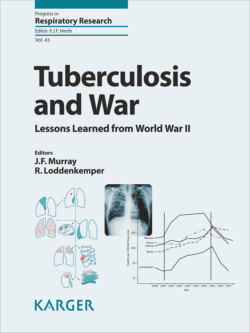Читать книгу Tuberculosis and War - Группа авторов - Страница 35
На сайте Литреса книга снята с продажи.
Abstract
ОглавлениеThe natural history of tuberculosis (TB) provides an intuitively clear pattern for the understanding of its epidemiology: exposure to the etiologic agent may result in latent infection with Mycobacterium tuberculosis without evidence of disease. Latent infection may then progress to overt clinical TB, and those afflicted may succumb to it. This sequence reflects a series of conditional probabilities in a cascade of events, each step hinging on the presence of its precedent step, for example, only a person infected with tubercle bacilli may develop TB, and only a person who is ill from TB can die from TB. These sequential probabilities vary by time, place, and person, resulting in observable temporally aligned metrics (infection, morbidity, mortality) defining the epidemic. These metrics are subject to measurement errors. As epidemiology bases its line of argumentation on comparisons, it uses relative measurements such as ratios, proportions, and rates. These depend on numerators (persons with or events of the condition sought) and denominators (the population from within which the persons come from or the events arise). Accurately enumerating events and counting populations is difficult, and these difficulties are compounded during wartime. This chapter focuses on identifying such challenges using examples from different settings during wartime.
© 2018 S. Karger AG, Basel
When discussing the epidemiology of tuberculosis (TB), it would be appropriate to refer back to the classification of TB proposed by the American Thoracic Society [1]. It follows the pathogenetic sequence and separates exposure (no evidence for latent infection), latent infection with Mycobacterium tuberculosis complex (without evidence of disease), TB (the disease), and death from M. tuberculosis. TB (the disease) has been subdivided into potentially transmissible forms (such as TB of the respiratory tract) and non-transmissible manifestations (such as most extrapulmonary forms; Fig. 1) [2, 3]. Conditional probabilities for progression from one step to the next in the chain of events are determined by various risk factors, both exogenous (such as exposure and acquisition of infection) and endogenous (such as progression from latent infection to overt clinical disease) [4].
This model will guide the following discussion on the challenges and difficulties in obtaining an accurate picture of the epidemiologic situation of TB during warfare using selected examples to illustrate attempts in ascertaining transmission of M. tuberculosis, TB, and death from M. tuberculosis, addressing both numerator and denominator issues that are always present in epidemiology, but become accentuated during wartime.
